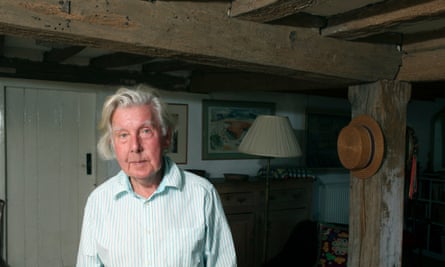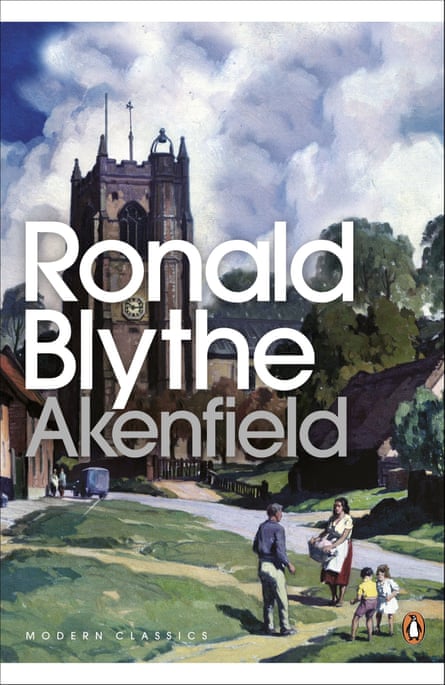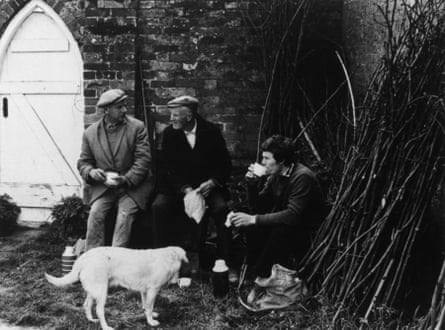In the summer of 1967, Ronald Blythe cycled from his home in the Suffolk hamlet of Debach to the neighbouring village of Charlsfield. There he listened to the voices of blacksmiths, gravediggers, nurses, horsemen and pig farmers. He gave them names from gravestones and placed them in a fictional village. Akenfield, a portrait of a rural life rapidly disappearing from view, was immediately acclaimed as a classic when it was published in 1969.
Never out of print and read and studied around the world, Akenfield made Blythe famous and perhaps overshadowed the many other fruits of his long years of writing – short stories, poems, histories, novels and, in later life, luminous essays and a superb weekly diary which the Church Times published for 25 years until 2017. Blythe, who has died aged 100, is regarded by his peers and many readers as the finest contemporary writer on the English countryside.
The eldest of six children, Blythe was born in Acton, near Lavenham, into a family of farm labourers rooted in rural Suffolk. His surname comes from the Blyth, a small Suffolk river, but his mother and her family were Londoners. His mother, Matilda (nee Elkins), a nurse, passed to him her love of books. Although Blythe left school at 14, by then he had already established a voracious reading habit – “never indoors, where one might be given something to do,” he remembered – which became his education.
His father, Albert, had served in the Suffolk Regiment and fought at Gallipoli and Blythe was conscripted during the second world war. Early on in his training, his superiors decided he was unfit for service – friends said he was incapable of hurting a fly – and he returned to East Anglia to work, quietly, as a reference librarian in Colchester library.
He befriended local writers including the poet James Turner, who helped his passage into a bohemian, creative Suffolk circle which included Sir Cedric Morris, who taught Lucian Freud and Maggi Hambling and lived nearby with his partner, Arthur Lett-Haines. Blythe “longed to be a writer”, he said, and he listened and learned – inspired by the example of poet friends including Turner (the unnamed poet in Akenfield) and WR Rodgers of how to live with very little money. “It was a kind of apprenticeship,” he once recalled.
Most importantly, in 1951 he met the artist Christine Kühlenthal, wife of the painter John Nash. Kühlenthal encouraged his writing and championed him: Blythe edited Aldeburgh festival programmes for Benjamin Britten and even ran errands for EM Forster, who took a shine to the shy young man. Blythe helped Forster compile an index for Forster’s 1956 biography of his great-aunt, Marianne Thornton.
Blythe’s first, Forster-inspired novel, A Treasonable Growth, was published in 1960. He followed it in 1963 with The Age of Illusion, a social history of life in England between the wars. He earned money from journalism, being a publishers’ “reader” and editing a series of classics – including one of his heroes, the essayist William Hazlitt – for the Penguin English Library.

After a stint living in Aldeburgh, recalled in an elegiac and characteristically discreet memoir, The Time by the Sea (2013), he moved to a cottage in Debach. In the mid-1960s, he was befriended by the American novelist Patricia Highsmith. “I admired her enormously. She was a very strange, mysterious woman. She was lesbian but at the same time she found men’s bodies beautiful,” he remembered. One evening, after a Paris literary do, they slept together; he told a friend they were both curious “to see how the other half did it”.
Blythe said the idea for Akenfield (he took the name from the old English “acen” for acorn) arrived as he tramped the Suffolk fields pondering the anonymity of most farm labourers’ lives. His friend Richard Mabey remembers it being commissioned by Viking as the lead title for a short-lived series on village life around the world.
Over 1967 and 1968, he listened to the citizens of Charsfield, recreating authentic country voices while somehow adding a poetry of his own. The result was a portrait of the “glory and bitterness” of the countryside: the penury and yet deep pride of the old, near-feudal farming life, and its obliteration in the 1960s by a second agricultural revolution alongside the arrival of the car and television.
The village voices were never sentimental about country life, and nor was Blythe: as well as stories of how to make corn dollies, there were quiet revelations of incest, and the district nurse recounted the old days when old people were stuffed into cupboards. Old labourers remembered the “meanness” of farmers who had treated their workers like machines because the big rural families delivered a seemingly endless supply of farm-fodder.

Ecstatic reviews of this “exceptional” and “delectable” book in Britain spread to North America, where Time praised it, John Updike loved it and Paul Newman wanted to film it. But some oral historians were suspicious that Blythe had not recorded his conversations.
Blythe turned down a film offer from the BBC but eventually accepted a pitch from the theatre director Peter Hall, a fellow Suffolk man. Blythe wrote a new synopsis inspired by the unfilmable book, and Hall asked ordinary rural people to improvise scenes with no script. Blythe oversaw every day of filming and played an apt cameo as a vicar. Nearly 15 million people watched Akenfield when it was broadcast on London Weekend Television in early 1975.
Blythe’s next book, The View in Winter (1979), was a prescient examination of old age in a society that did not value it, at a time when more people than ever reached it. The “disaster” suffered by the old, he wrote, is “nobody sees them any more as they see themselves”. Blythe regarded it as his best book. While he was writing it, Kühlenthal died, and Blythe moved into the Nashes’ old farm, Bottengoms, to look after the elderly Nash. When Nash died a year later, he left the house to Blythe. There Blythe lived for the rest of his life, writing beautifully about his home in At the Yeoman’s House (2011).
In later years, Blythe drew praise for his short stories and essays, including a series of meditations on the 19th-century rural poet John Clare. Many writers who were later grouped together as “nature writers” became his friends, including Mabey, Robert Macfarlane and Roger Deakin.
Blythe never married, never lived with anyone, and kept his personal life veiled. Interviewed by the Observer in November 1969, he was judged “intensely private”. He disclosed nothing in his published writing about his love affairs with men, or indeed his one-night stand with Highsmith.

He was almost as reticent about his faith, but his writing was deeply suffused in his Christian beliefs and his knowledge of the scriptures. He was a lay reader – deputising for vicars across several parishes – and became a lay canon of St Edmundsbury Cathedral, but turned down the chance to become a priest.
Rowan Williams, the former archbishop of Canterbury and an admirer of Blythe’s writing, believed Blythe used the Christian year of festivals as “a steady backdrop” for his writing and thinking, which was liberated by his faith. The writer Ian Collins, a good friend of Blythe in his later years, felt it was Blythe’s lack of formal education or “training” that liberated his original thinking and elegant prose style.
Blythe was politically radical throughout his life, a Labour voter who joined peace vigils outside St-Martin-in-the-Fields in London. Friends were surprised when he accepted a CBE in 2017, around the time he was gently “retired” from public speaking and writing as his short-term memory faded. When he reached 100, he was still well enough to sign 1,500 copies of a new compilation of his best Church Times columns.
The old people who thrived in The View in Winter were those, Blythe concluded, who were able to preserve their “spiritual vitality, a vividness, an imaginative sort of energy”. This credo served him well as he grew older, although he was mistaken in another respect. The old, he wrote, are “cared for, surrounded with kindliness, and people are often interested in what they say; but they are not truly loved and they know it”.
Blythe was much loved in later life. A roster of devoted friends he called his “dear ones” visited him daily, supplied him with hot meals and ensured he could live out his years at Bottengoms.

 1 year ago
94
1 year ago
94










 English (US)
English (US)